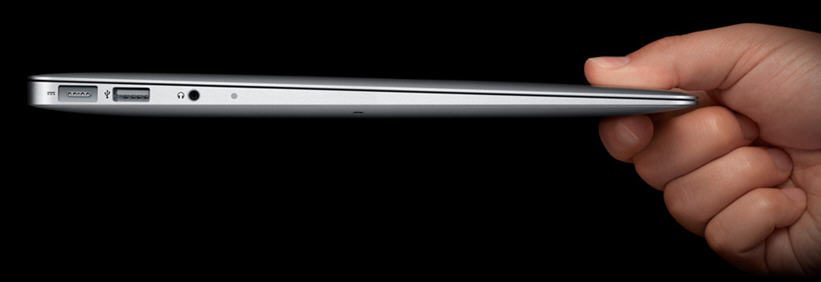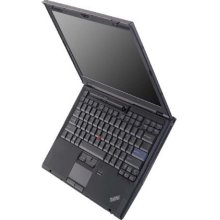
Apple’s lightest and thinnest notebook PC (Credit: Apple.com)
Laptop PCs are back in the news and, as usual, Steve Jobs gets the credit. Last week’s announcement of two new MacBook Air ultralight notebooks got a lot of attention, partially because of their size and weight but mainly because they have no hard drive; instead they use flash memory as a “solid state drive” (SSD) for storage.
As he announced the laptops, Jobs proclaimed its design as “the future of the MacBook” and went so far as to say “All notebooks will be like this someday.”
He’s probably right. Like other technologies from the 1980s, the hard drive is starting to outlive its usefulness, at least when it comes to internal storage for portable devices. For laptops, flash memory makes sense — at least for a portion of the market.
It didn’t take Jobs to convince me about the benefits of flash storage. I fell in love with an SSD-equipped laptop more than two years ago when I got my hands on a Lenovo X300. It was very expensive at the time — nearly $3,000 out the door — but it sold me on the advantages of a machine that started faster, ran quieter, used less energy and — most important — wasn’t subject to hard drive crashes. For a butterfingers guy like me, having a laptop without a drive means that when I drop it or if it falls off a table (yes, it’s happened more than once) I don’t have to panic about whether my data will still be there because, unlike a hard drive, SSDs have no moving parts and no heads to crash against a delicate spinning drive surface.
Aside from price, the big compromise on SSD machines is that you have to live with less storage. The MacBook Air ranges from 64 gigabytes for the $999 11-inch model up to 256 GB as an option on the 13-inch model for anyone willing to spend $1,599. That’s a lot less storage than a laptop hard drive, which typically range from 160 GB to more than 500 GB.
Apple doesn’t even offer hard drives on its new MacBook Air but it does offer both types of storage on its MacBook Pro and, as you’d expect, the SSD option substantially adds to the price as it substantially subtracts from the storage. The base MacBook Pro with a 320 GB hard drive costs $1,499 but if you want a 128 GB SSD instead, you not only give up space but pay an extra $300.
Cost issues aside, having to cut back on storage is a trade-off I’m willing to make when I’m on the road.
My Two-Old Windows Laptop with a Solid State Drive

Lenovo X300 Notebook PC with Solid State Drive
The Lenovo X300 that I’m carrying around right now has only 64 GB of storage, tiny compared to the nearly two terabytes of storage on my home PC. And, unlike my home machine, it has a 13-inch screen instead of two 21-inch monitors. It also has a slower processor and lacks quite a few other bells and whistles but carrying around a sub-3 pound notebook is a lot easier on my back and shoulders, especially all day at a trade show.
When I leave the house, size and weight matter more than the ability to access every photograph, video and MP3 file in my collection. And, because all my important data is stored on my desktop PC, I wouldn’t panic (as much) if I lost or broke my laptop, which is a lot more likely than losing a machine that never leaves the house.
As it turns out, 64 GB is more than enough room for the operating system and quite a few essential applications like Microsoft Office, a couple of browsers, a video editing program and all the data files I need on the road including weeks’ worth of my one-minute daily recorded radio segments, hundreds of Microsoft Word files, quite a few PowerPoint presentations, some short videos and even a couple of full length (2 GB each) movies.
And if you do need more space, you can always plug in an external USB hard drive, including one of the ultra-portable drives that don’t even require external power like Seagate’s 1.5 terabyte drive, which weighs just over half a pound.
Giant Hard Drive in the Sky
And if that’s not enough, there is that giant “hard drive” in the sky. Thanks to the growing use of “cloud storage,” we don’t need as much local storage as we once did. I used to have an enormous Outlook data file but now my contact list, calendar and four years’ worth of e-mail messages and attachments are stored online, courtesy of Google’s Gmail. I still keep a local copy of my photographs on my hard drive but now it’s possible to store those online as well. And thanks to streaming video services like Amazon and Netflix, the only reason to store movies and TV shows is to watch them on airplanes, but even that’s changing thanks to GoGo In-flight Wi-Fi.
Of course, there are all those music files on my hard drive but I’m guessing Apple has an answer for that too. Rumor has it that the reason they purchased and shuttered Lala.comwas so they could offer a cloud-based version of iTunes.
This article first appeared in the San Jose Mercury News

Larry Magid is a technology journalist and an Internet safety advocate. He serves as on-air technology analyst for CBS News, is co-director of ConnectSafely.org and founder of SafeKids.com and SafeTeens.com. He also writes columns that appear on CNET News, CBSNews.com, Huffington Post and the San Jose Mercury News.
His technology reports can be heard daily on CBS News and CBS affiliates throughout the U.S. and he has a daily tech segment on KCBS radio in San Francisco. He’s a regular contributor to BBC World Service and an occasional guest on National Public Radio’s Talk of the Nation. He is often called upon for commentary by CBS television news, CNN and Fox News and has appeared on the CBS Evening News, ABC World News Tonight, the Today Show and CBS Early Show. He has also been a frequent contributor to the New York Times and was, for 18 years, a syndicated columnist for the Los Angeles Times.
He has written several books including the best-selling Little PC Book and is co-author (with Anne Collier) of MySpace Unraveled.
Larry served on the Obama Administration’s Online Technology Working Group and the Berkman Center’s Internet Safety Technology Task Force.








